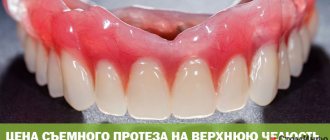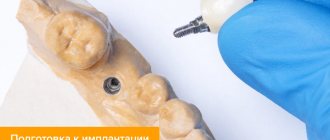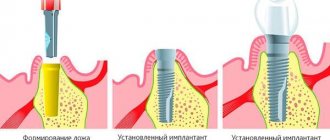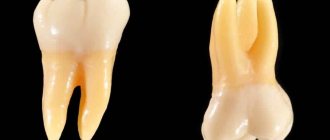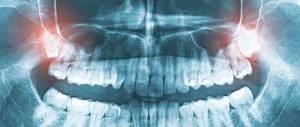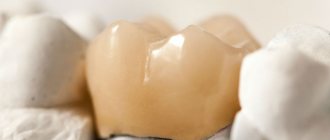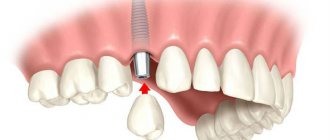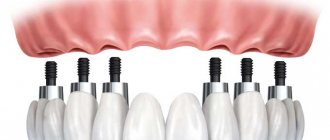Implantation in the lower jaw is carried out in the absence of one, several or all teeth.
The bone tissue here has a denser structure, and the chewing teeth experience maximum stress. The lower jaw bone does not lose volume as rapidly, so if less than 2 years have passed since tooth extraction, there is no need for bone grafting. If the bone is thinned, it is more difficult to restore it than the upper one. The optimal method for implanting lower teeth is a classic two-stage method: first, the implant is securely installed and only after it has completely engrafted, the crown is fixed. Simultaneous loading is indicated only in cases where it is necessary to restore the teeth of the frontal group. Optimal implants are relatively long, with a wide diameter.
Implantology (dentistry) Price
Consultation with an implant surgeon 0 rubles
Bone grafting of the 1st degree of complexity (without the use of osteoplastic material) 14,000 rubles
Bone grafting, 2nd degree of complexity (without the use of osteoplastic material) 20,000 rubles
Bone augmentation in the area of 1 tooth 7,000 rubles
Installation of the shaper 2,500 rubles
Sinus lift operation (closed method) 15,000 rubles
Sinus lifting, open, unilateral (excluding cost of material) 25,000 rubles
Implant removal 4,000 rubles
Installation of an orthopedic mini-implant 20,000 rubles
Installation of a mini-implant for a removable denture 20,000 rubles
Installation of the 1st Alfa Bio implant (Israel), including the cost of the implant, gum former, surgery. 17,000 20,000 rubles
Installation of the 1st Neo Biotech implant (Korea), including the cost of the implant, gum former, surgery. 17,000 20,000 rubles
Installation of the 1st implant Implantium (Korea), including the cost of the implant, gum former, surgery. 23,800 28,000 rubles
Installation of the 1st Astra Tech implant (Sweden), including the cost of the implant, gum former, surgery. 42,500 50,000 rubles
Installation of the 1st implant STRAUMANN SLA (Switzerland), including the cost of the implant, gum former, surgery. 36,975 43,500 rubles
Installation of the 1st STRAUMANN SLAktive implant (Switzerland), including the cost of the implant, gum former, surgery. 42,500 50,000 rubles
Installation of the 1st Nobel implant (USA, Sweden) 43,350 51,000 rubles
Installation of the 1st OSSTEM implant (Korea) 21,000 28,000 rubles
Inspection after implant installation 0 rubles
Using a bone scraper 5,000 rubles
Use of bone auto-block 45,000 rubles
Methods of prosthetics for complete absence of teeth
With complete edentia, it is possible to restore the dentition in two ways. The first is the production of a complete removable denture, the second is the installation of implant-supported dentures. The latter method is divided into two types: fixed and removable prosthetics. If we talk about choosing the most optimal treatment option, then in the case of complete absence of teeth, experts recommend dental implantation.
Indications for use
- Multiple or complete edentia.
- The presence of contraindications to implantation or the patient’s reluctance to place implants (the overdenture is an independent orthopedic structure).
- Having an allergy to metal.
- As a temporary prosthesis. This is relevant during the healing of implants or before classical prosthetics.
- As a temporary or permanent complete denture on implants.
Cover prostheses have no obvious contraindications. The exception is active periodontal disease, mental illness and allergies caused by the presence of monomers contained in acrylic plastic.
What are the advantages of implantation with complete edentia?
The main advantage of an implant-supported prosthesis is the reliability of its fixation. Such a denture will never fall out of your mouth at the most inopportune moment. In cases of wearing a complete removable denture, this happens quite often, since the structure is held in the oral cavity due to the suction effect of the palate, the protrusions of the jaw bone and the force of gravity (on the lower jaw). As for fixing gels, firstly, they quite often cause allergies, and secondly, they only help if the error between the prosthetic bed and the prosthesis itself is minimal. If a person has not re-aligned the orthopedic structure for more than three years, in order to securely fasten it, it will be necessary to squeeze out half a tube of the product, which is “eaten” within 5-6 hours, and this, in turn, is fraught with serious gastrointestinal disorders.
It is worth noting that there are a number of methods for improving the fixation and stabilization of such a prosthesis, but no matter how masterfully the doctor masters prosthetic techniques, with complete edentia, wearing a classic complete removable denture still significantly reduces the patient’s quality of life. In addition, a removable denture leads to further bone tissue atrophy, which complicates the implantation procedure in the future.
Manufacturing procedure and materials
The production of a covering prosthesis takes place in several stages. In general, the entire process takes less time when compared with classic prosthetics.
✔
Consultation, examination of the oral cavity, radiographic examination.
✔
The choice of orthopedic design depends on the clinical case and the wishes of the patient.
✔
Taking impressions.
✔
Making plaster and wax models taking into account anatomical features and bite.
✔
Making the base of the prosthesis.
✔
Fixation of artificial teeth.
✔
Processing and polishing of the prosthesis.
✔
Installation of a covering prosthesis.
Much depends on the material of the prosthesis. Currently, overdentures are made from acrylic plastic, acrylic-free plastic and nylon. Plastic is a durable material that copes well with the chewing load, but it can injure the mucous membrane and cause allergies due to the presence of harmful monomers in the composition. Nylon dentures are soft, comfortable and very aesthetic, but are not suitable for installation on a completely toothless jaw, since they do not have sufficient rigidity for comfortable chewing. One of the best options is a prosthesis made of acrylic-free plastic, which has the required rigidity, but is also safe for soft tissues.
- Restoration of chewing function (with implantation - almost in full).
- Not bad aesthetics.
- Fast production times.
- The ability to independently remove and clean the prosthesis.
- Affordable price (if we are not talking about a prosthesis on implants).
- The overdenture itself is unable to completely restore the functionality of the teeth and stop bone tissue atrophy.
- Requires careful care.
- Limited service life (from 3 to 7 years depending on the material).
How serious is the gag reflex problem when wearing a classic removable denture?
The gag reflex occurs quite often when using complete removable dentures. Moreover, there are no methods to help rid a patient of it, because this is, in fact, an individual reaction of the body. The fact is that such dentures on the upper jaw must end at the so-called line A, where the hard palate meets the soft palate, otherwise they will not hold. Often, a gag reflex can occur even when taking impressions. In order to carry out the procedure, the doctor has to prescribe the person sedatives or sedation. But if the patient cannot endure the procedure of taking impressions without discomfort, a reasonable question arises: how will he cope with wearing the prosthesis itself?
Question 4: Is it possible to install several implants at once?
Yes, you can. But quantity plays a role. For example, surgeons place one or two artificial roots at a time.
It is always worth remembering that implantation is a surgical intervention and stress for the body. In order not to overload your health, the surgeon draws up an implantation calendar, where he clearly states the dates of operations. This will distribute the load on the body.
Note! There is no need to rush to insert all the missing teeth at the same time. Let this process be systematic. By waiting a few months, you will receive guarantees that the roots will take root reliably and withstand all the load that will fall on them.
Advantages of full implantation in terms of ease of eating
If we compare chewing efficiency with classic removable prosthetics and with implant-supported prosthetics, in the latter case it increases significantly, and, as is known, the quality of chewing food affects the condition of the gastrointestinal tract and the body as a whole. Owners of complete removable dentures have to regularly contact a gastroenterologist, who can only offer them to put food through a blender, but any person wants to eat well.
It is also worth noting that the process of chewing with the help of a complete removable denture constantly causes pain, since the structure puts pressure on the mucous membrane, under which there is a periosteum with many nerve endings. When the denture is installed supported by implants, there is no pain, since there is no pressure on the soft tissues.
Question 5: Are there any age restrictions?
There are practically no age restrictions for dental implantation. Implants are allowed to be placed in young patients after the final formation of the dental system (about 18 – 20 years), and in adults, teeth can be implanted at 70 and 90 years.
If a child under 18 years of age needs to place an artificial pin instead of a molar, the dentist may suggest using a temporary implant and after a while placing a permanent one.
Implantation in the absence of teeth - how many implants are needed?
The maximum implantation of teeth in the lower jaw, as well as in the upper jaw, is carried out with the installation of up to 14 implants, on each of which a separate crown is fixed - that is, a complete dentition is recreated, not counting wisdom teeth. But this method is not suitable for all patients, since it requires a sufficient volume of bone tissue, and restrictions may also arise due to the proximity of nerves. In addition, installing 28 implants on both jaws using the same number of crowns is a rather expensive procedure, which is not always justified. As for the minimum number of implants, there can be only 8 of them - four on each jaw. This technique is also called “all-on-four implantation.” However, to achieve optimal results, experts recommend 12 - six on each jaw.
All turnkey implantation services:
| Implantation SGS PROMOTION — 37500 rub. 70000 rub. Implantation Osstem PROMOTION - 39,500 rub. 75500 rub. Dentium implantation PROMOTION - 45,000 rub. 65000 rub. Implantation Astra Tech PROMOTION - 85,000 rub. 120500 rub. Implantation Nobel Biocare PROMOTION - 85,000 rub. 86000 rub. Implantation Straumann PROMOTION - 85,000 rub. 88000 rub. Implantation MIS - 60,000 rub. Implantation Zimmer - 159,000 rub. Full implantation "all-on-four" PROMOTION - 159,000 rub. 250,000 rub. Full implantation “all-on-six” PROMOTION - RUR 199,000. 350000 rub. | The cost of turnkey implantation includes:⦁ Consultation with an implantologist; ⦁ Drawing up a treatment plan; ⦁ Implant installation surgery; ⦁ Application and removal of sutures; ⦁ Installation of a gum former; ⦁ Taking impressions; ⦁ Manufacturing and fixation of a zirconium crown on an implant |
Implantation in combination with removable or fixed prosthetics is a highly effective and proven method of treating complete adentia, allowing you to return not only chewing function to normal, but also the aesthetics of teeth. |
Is it possible to install mini-implants with complete edentia?
There are certain indications for mini-implants. The main thing is a narrow alveolar ridge, into which it is impossible to install standard-sized implants without replanting bone material. Naturally, osteoplastic surgery increases the cost of the procedure, so many patients prefer more affordable treatment with mini-implants. However, oddly enough, it does not differ much in cost from conventional implantation and, moreover, is associated with certain difficulties.
The main feature of mini-implants is that, unlike classical designs, they are non-removable, that is, they do not require the installation of an abutment. Crowns or bridges are installed directly on the tip of the implant, which acts as a kind of lock. Such a unique structure of the implant imposes certain obligations on the specialist and requires special skills from him. Firstly, mini-implants must be installed strictly parallel to each other, otherwise the prosthesis attached to them will not fit tightly in the oral cavity. And secondly, the load exerted on the structure must be minimal, otherwise there is a risk of rejection.
Question 2: Are there any contraindications for the implantation procedure?
Yes, I have. But every year there are fewer and fewer of them. Dentistry is rapidly developing, trying to make implantation more accessible, including to those people who could have been denied such manipulation just a few years ago.
The following are considered absolute contraindications:
- diseases of the central nervous system;
- severe forms of diabetes;
- cancerous tumors;
- systemic bone lesions.
Relative contraindications include:
- viral infections and inflammatory processes;
- pregnancy and lactation;
- poor oral hygiene.
Cost of full dental implantation
Similar treatment in Moscow dentistry, including all accompanying procedures, is offered at a cost of 180,000 rubles and more. The price of implantation in the absence of teeth will be higher if a larger number of implants are installed, and more expensive materials are used to make the prosthesis itself. In any case, even the cheapest prosthetics on implants will be an order of magnitude better than a classic removable denture, which significantly reduces a person’s quality of life, especially when it comes to elderly patients.
Cover prosthesis - what does it mean?
Overlay (plate, removable) dentures are products that have a soft base that imitates part of the oral mucosa, and artificial teeth. There are quite a few varieties, but they are all removable, that is, the patient can independently remove them and install them back. Such dentures are often popularly called false jaws. This is partly true: those same teeth in a glass that appear so often in movies and TV series are also overdentures. Moreover, today removable overdentures are often placed on implants, which gives this orthopedic product a completely different status. Due to their versatility, overdentures have a significant list of indications.
How much does implantation cost in the upper jaw?
As a rule, the price consists of the cost of implants, bone grafting or sinus lift, as well as dental crowns or complete dentures. In Moscow, prices for implants start from 30,000 - 70,000 rubles, depending on the manufacturer. We add bone grafting to this cost at costs ranging from 15,000 rubles to 50,000 rubles. Plus we choose crowns: metal-ceramic crowns - from 10,000 rubles to 20,000 rubles per unit, solid ceramic crowns will cost 40,000 - 50,000 rubles, and zirconium crowns - from 35,000 rubles.
Publisher: Expert magazine about dentistry Startsmile.ru
How to install
- Incision, gum detachment in the area of operation.
- Using dental drills, prepares the hole.
- Screwing in, driving in the implant, installing a plug.
- After healing, a gum former and abutment are placed.
- Crown installation.
Main stages of dental implant installation
Question 6: How painful is the implant procedure?
The procedure itself does not cause pain or discomfort. The patient is first given anesthesia, which completely removes the pain. During the process of inserting a titanium pin, a person can watch a movie, listen to music or an audio book - he will not feel any discomfort.
Pain may be bothersome after the anesthesia wears off. But for this, the dentist prescribes painkillers to the patient to relieve pain and general discomfort. The pain should completely subside 3 to 5 days after installation of the implant. If it continues and is accompanied by swelling and fever, you should definitely consult your doctor.
How many implants can be implanted at the same time?
If the patient is missing several teeth, it is better to place the required number of titanium roots at one time. This way you won’t have to undergo anesthesia again. In addition, after surgery, antibacterial therapy is prescribed. It is not advisable to carry it out more than once. In general, up to 6-8 dental implants can be implanted at one time.
Implantologist's opinion : “For an experienced dentist, installing 2, 3, 4 implants at a time is not a problem. However, you should not delay the duration of the procedure too much - not every patient will undergo such a volume of anesthesia without harm to the body.”
